Steam Explosion Pretreatment of Sludge for Pharmaceutical Removal and Heavy Metal Release to Improve Biodegradability and Biogas Production
Abstract
1. Introduction
2. Materials and Methods
2.1. Sludge and Inoculum
2.2. Steam Explosion Pretreatment Procedure
2.3. Anaerobic Digestion Process
2.4. Analytical Methods
2.5. Statistical Analysis
3. Results and Discussion
3.1. Effect of Steam Explosion on Heavy Metal Release
3.2. Effect of Steam Explosion on Pharmaceutical Removal
3.3. Effect of Steam Explosion Pretreatment on the Sludge Properties
3.4. Effect of the Steam Explosion on Biogas Production
3.4.1. Effect of Solubilization on Biodegradability
3.4.2. Effect of Reduction of the Pharmaceuticals and Heavy Metals on Biodegradability
4. Conclusions
Author Contributions
Acknowledgments
Conflicts of Interest
References
- Pilli, S.; Yan, S.; Tyagi, R.; Surampalli, R.Y. Thermal Pretreatment of Sewage Sludge to Enhance Anaerobic Digestion: A Review. Crit. Rev. Environ. Sci. Technol. 2014, 45, 669–702. [Google Scholar] [CrossRef]
- Zhang, Q.; Hu, J.; Lee, D.-J.; Chang, Y.; Lee, Y.-J. Sludge treatment: Current research trends. Bioresour. Technol. 2017, 243, 1159–1172. [Google Scholar] [CrossRef]
- Liu, T.; Liu, Z.; Zheng, Q.; Lang, Q.; Xia, Y.; Peng, N.; Gai, C. Effect of hydrothermal carbonization on migration and environmental risk of heavy metals in sewage sludge during pyrolysis. Bioresour. Technol. 2018, 247, 282–290. [Google Scholar] [CrossRef]
- Li, W.C. Occurrence, sources, and fate of pharmaceuticals in aquatic environment and soil. Environ. Pollut. 2014, 187, 193–201. [Google Scholar] [CrossRef]
- Ashrafi, O.; Yerushalmi, L.; Haghighat, F. Wastewater treatment in the pulp-and-paper industry: A review of treatment processes and the associated greenhouse gas emission. J. Environ. Manag. 2015, 158, 146–157. [Google Scholar] [CrossRef]
- Cano, R.; Pérez-Elvira, S.I.; Fdz-Polanco, F. Energy feasibility study of sludge pretreatments: A review. Appl. Energy 2015, 149, 176–185. [Google Scholar] [CrossRef]
- Appels, L.; Baeyens, J.; Degreve, J.; Dewil, R. Principles and potential of the anaerobic digestion of waste-activated sludge. Prog. Energy Combust. Sci. 2008, 34, 755–781. [Google Scholar] [CrossRef]
- Kim, D.; Lee, K.; Park, K.Y. Enhancement of biogas production from anaerobic digestion of waste activated sludge by hydrothermal pre-treatment. Int. Biodeterior. Biodegrad. 2015, 101, 42–46. [Google Scholar] [CrossRef]
- Nielfa, A.; Cano, R.; Fdz-Polanco, M. Theoretical methane production generated by the co-digestion of organic fraction municipal solid waste and biological sludge. Biotechnol. Rep. 2014, 5, 14–21. [Google Scholar] [CrossRef]
- Browne, J.D.; Allen, E.; Murphy, J.D. Evaluation of the biomethane potential from multiple waste streams for a proposed community scale anaerobic digester. Environ. Technol. 2013, 34, 2027–2038. [Google Scholar] [CrossRef]
- Qiao, W.; Yan, X.; Ye, J.; Sun, Y.; Wang, W.; Zhang, Z. Evaluation of biogas production from different biomass wastes with/without hydrothermal pretreatment. Renew. Energy 2011, 36, 3313–3318. [Google Scholar] [CrossRef]
- Naran, E.; Toor, U.A.; Kim, D.-J. Effect of pretreatment and anaerobic co-digestion of food waste and waste activated sludge on stabilization and methane production. Int. Biodeterior. Biodegrad. 2016, 113, 17–21. [Google Scholar] [CrossRef]
- Davidsson, Å.; Kjerstadius, H.; Haghighatafshar, S.; Fick, J.; Olsson, M.; Wachtmeister, H.; Eriksson, E.; Jansen, J.L.C. Effect of anaerobic digestion at 35, 55 and 60 °C on pharmaceuticals and organic contaminants. Water Sci. Technol. 2014, 69, 1282–1288. [Google Scholar] [CrossRef] [PubMed]
- Yi, H.; Han, Y.; Zhuo, Y. Effect of Combined Pretreatment of Waste Activated Sludge for Anaerobic Digestion Process. Procedia Environ. Sci. 2013, 18, 716–721. [Google Scholar] [CrossRef]
- Abdel-Shafy, H.I.; Mansour, M.S. Biogas production as affected by heavy metals in the anaerobic digestion of sludge. Egypt. J. Pet. 2014, 23, 409–417. [Google Scholar] [CrossRef]
- Johnson, D.K.; Elander, R.T. Pretreatments for Enhanced Digestibility of Feedstocks. Biomass Recalcitrance 2009, 436–453. [Google Scholar]
- Dereix, M.; Parker, W.; Kennedy, K. Steam-explosion pretreatment for enhancing anaerobic digestion of municipal wastewater sludge. Water Environ. Res. 2006, 78, 474–485. [Google Scholar] [CrossRef]
- Lotfi Aski, A.; Borghei, A.; Zenouzi, A.; Ashrafi, N.; Taherzadeh, M.J. Effect of Steam Explosion on the Structural Modification of Rice Straw for Enhanced Biodegradation and Biogas Production. BioResources 2018, 14, 1–464. [Google Scholar]
- Hansen, T.L.; Schmidt, J.E.; Angelidaki, I.; Marca, E.; Jansen, J.L.C.; Mosbæk, H.; Christensen, T.H. Method for determination of methane potentials of solid organic waste. Waste Manag. 2004, 24, 393–400. [Google Scholar] [CrossRef]
- Gros, M.; Petrovic, M.; Barceló, J. Tracing Pharmaceutical Residues of Different Therapeutic Classes in Environmental Waters by Using Liquid Chromatography/Quadrupole-Linear Ion Trap Mass Spectrometry and Automated Library Searching. Anal. Chem. 2009, 81, 898–912. [Google Scholar] [CrossRef]
- McCrady, M.H. Standard methods for the examination of water and waste-water (12th ed.). Am. J. Public Health Nations Health 1966, 56, 684. [Google Scholar] [CrossRef]
- Teghammar, A.; Yngvesson, J.; Lundin, M.; Taherzadeh, M.J.; Horváth, I.S. Pretreatment of paper tube residuals for improved biogas production. Bioresour. Technol. 2010, 101, 1206–1212. [Google Scholar] [CrossRef] [PubMed]
- Boyle, W. Energy recovery from sanitary landfills—A review. In Microbial Energy Conversion; Elsevier BV: Göttingen, Germany, 1977; pp. 119–138. [Google Scholar]
- Li, Y.; Zhang, R.; Liu, G.; Chen, C.; He, Y.; Liu, X. Comparison of methane production potential, biodegradability, and kinetics of different organic substrates. Bioresour. Technol. 2013, 149, 565–569. [Google Scholar] [CrossRef] [PubMed]
- Vlyssides, A. Thermal-alkaline solubilization of waste activated sludge as a pre-treatment stage for anaerobic digestion. Bioresour. Technol. 2004, 91, 201–206. [Google Scholar] [CrossRef]
- Fu, F.; Wang, Q. Removal of heavy metal ions from wastewaters: A review. J. Environ. Manag. 2011, 92, 407–418. [Google Scholar] [CrossRef] [PubMed]
- Shi, W.; Liu, C.; Ding, D.; Lei, Z.; Yang, Y.; Feng, C.; Zhang, Z. Immobilization of heavy metals in sewage sludge by using subcritical water technology. Bioresour. Technol. 2013, 137, 18–24. [Google Scholar] [CrossRef] [PubMed]
- Huang, H.; Yuan, X.-Z. The migration and transformation behaviors of heavy metals during the hydrothermal treatment of sewage sludge. Bioresour. Technol. 2016, 200, 991–998. [Google Scholar] [CrossRef] [PubMed]
- Dewil, R.; Baeyens, J.; Appels, L. Enhancing the use of waste activated sludge as bio-fuel through selectively reducing its heavy metal content. J. Hazard. Mater. 2007, 144, 703–707. [Google Scholar] [CrossRef]
- Appels, L.; Degreve, J.; Van Der Bruggen, B.; Van Impe, J.F.M.; Dewil, R. Influence of low temperature thermal pre-treatment on sludge solubilisation, heavy metal release and anaerobic digestion. Bioresour. Technol. 2010, 101, 5743–5748. [Google Scholar] [CrossRef]
- Malmborg, J.; Magnér, J. Pharmaceutical residues in sewage sludge: Effect of sanitization and anaerobic digestion. J. Environ. Manag. 2015, 153, 1–10. [Google Scholar] [CrossRef]
- Behera, S.K.; Kim, H.-W.; Oh, J.-E.; Park, H.-S. Occurrence and removal of antibiotics, hormones and several other pharmaceuticals in wastewater treatment plants of the largest industrial city of Korea. Sci. Total Environ. 2011, 409, 4351–4360. [Google Scholar] [CrossRef] [PubMed]
- Stasinakis, A.S. Review on the fate of emerging contaminants during sludge anaerobic digestion. Bioresour. Technol. 2012, 121, 432–440. [Google Scholar] [CrossRef] [PubMed]
- Li, C.; Wang, X.; Zhang, G.; Yu, G.; Lin, J.; Wang, Y. Hydrothermal and alkaline hydrothermal pretreatments plus anaerobic digestion of sewage sludge for dewatering and biogas production: Bench-scale research and pilot-scale verification. Water Res. 2017, 117, 49–57. [Google Scholar] [CrossRef] [PubMed]
- Guan, B.-H.; Yu, J.; Fu, H.; Guo, M.; Xu, X. Improvement of activated sludge dewaterability by mild thermal treatment in CaCl2 solution. Water Res. 2012, 46, 425–432. [Google Scholar] [CrossRef] [PubMed]
- Wang, L.; Li, A. Hydrothermal treatment coupled with mechanical expression at increased temperature for excess sludge dewatering: The dewatering performance and the characteristics of products. Water Res. 2015, 68, 291–303. [Google Scholar] [CrossRef] [PubMed]
- Sapkaite, I.; Barrado, E.; Fdz-Polanco, F.; Pérez-Elvira, S.I. Optimization of a thermal hydrolysis process for sludge pre-treatment. J. Environ. Manag. 2017, 192, 25–30. [Google Scholar] [CrossRef]
- Yang, S.; McDonald, J.; Hai, F.I.; Price, W.; Khan, S.; Nghiem, L.D. Effects of thermal pre-treatment and recuperative thickening on the fate of trace organic contaminants during anaerobic digestion of sewage sludge. Int. Biodeterior. Biodegrad. 2017, 124, 146–154. [Google Scholar] [CrossRef]
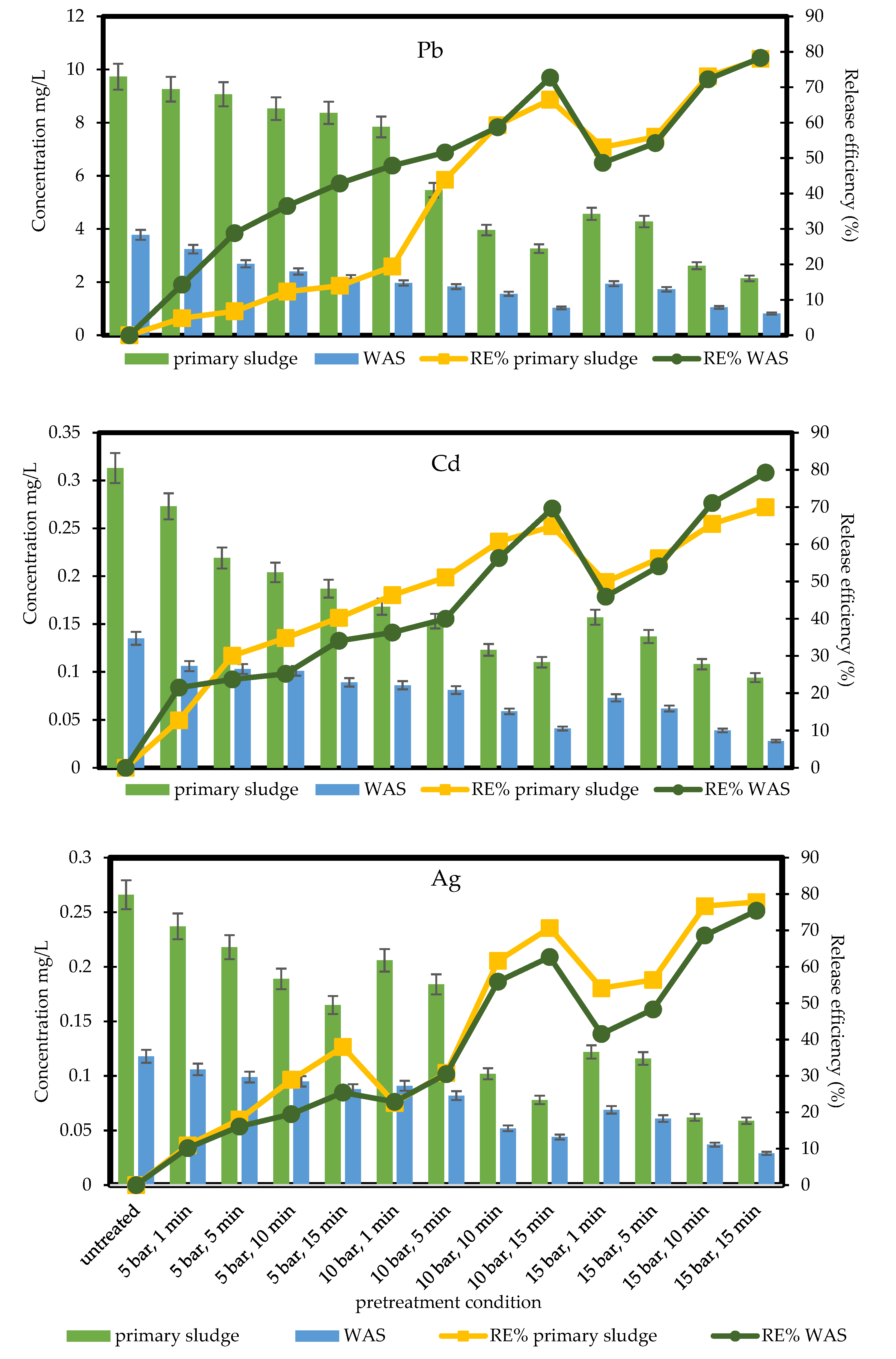
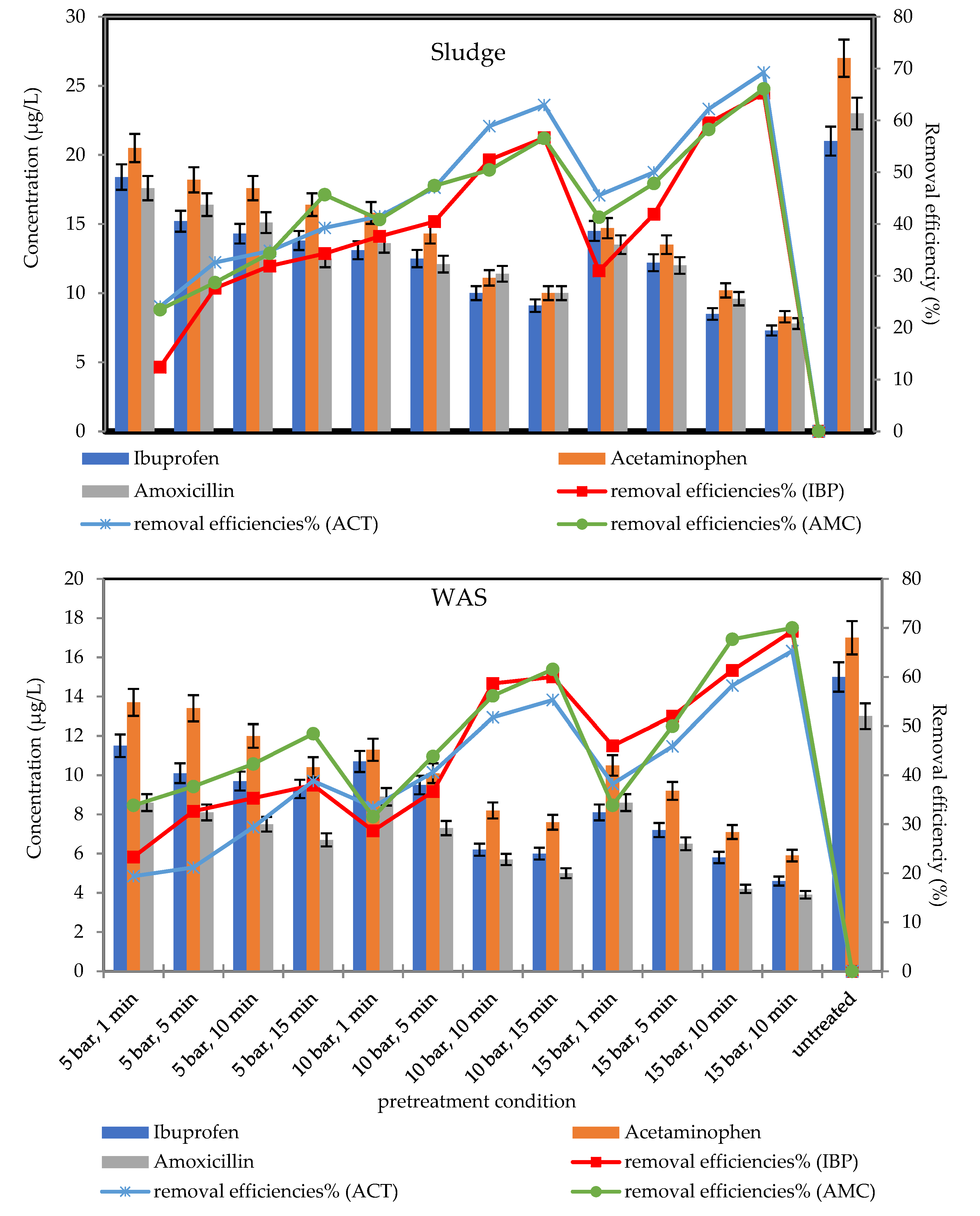

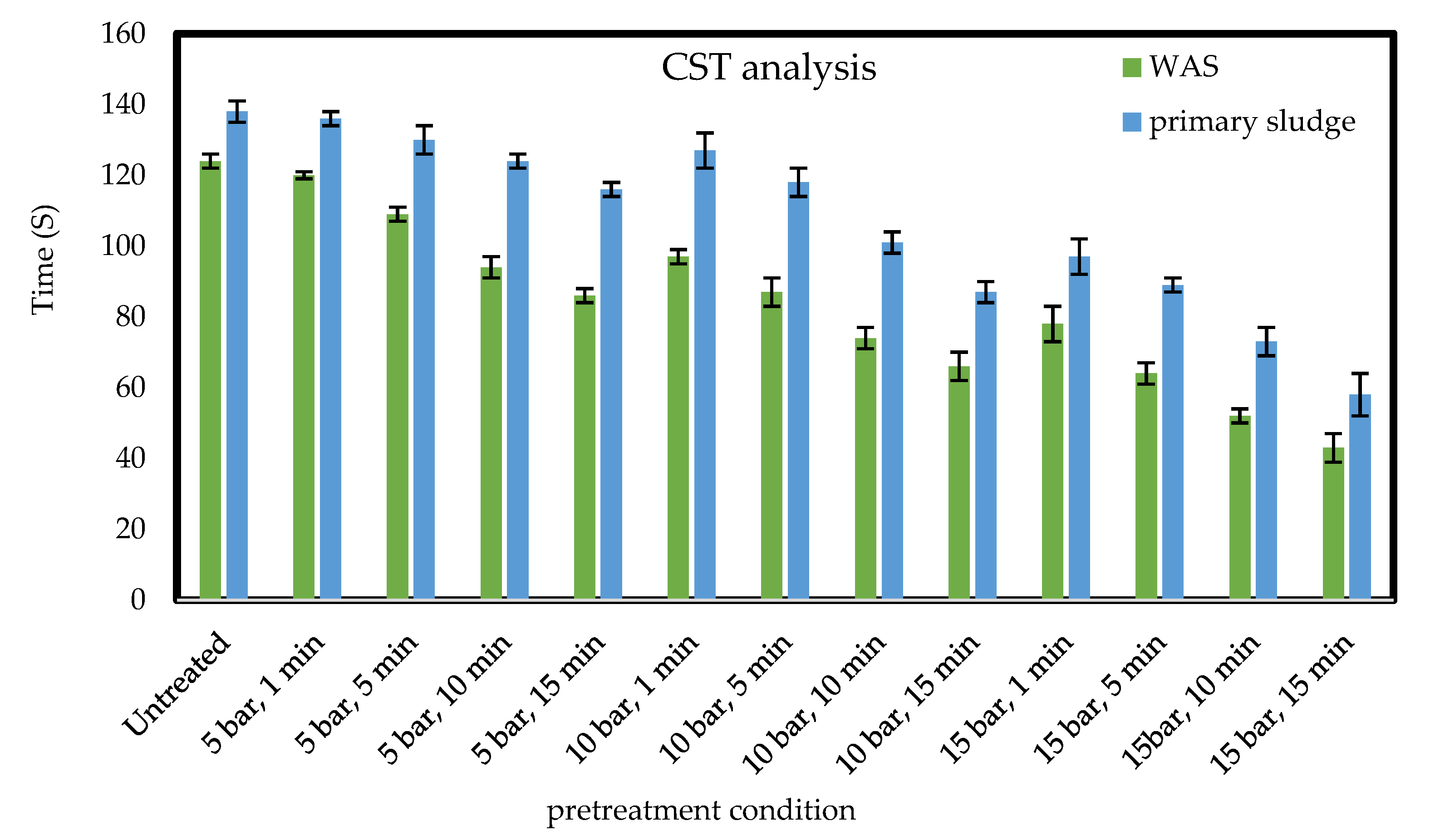
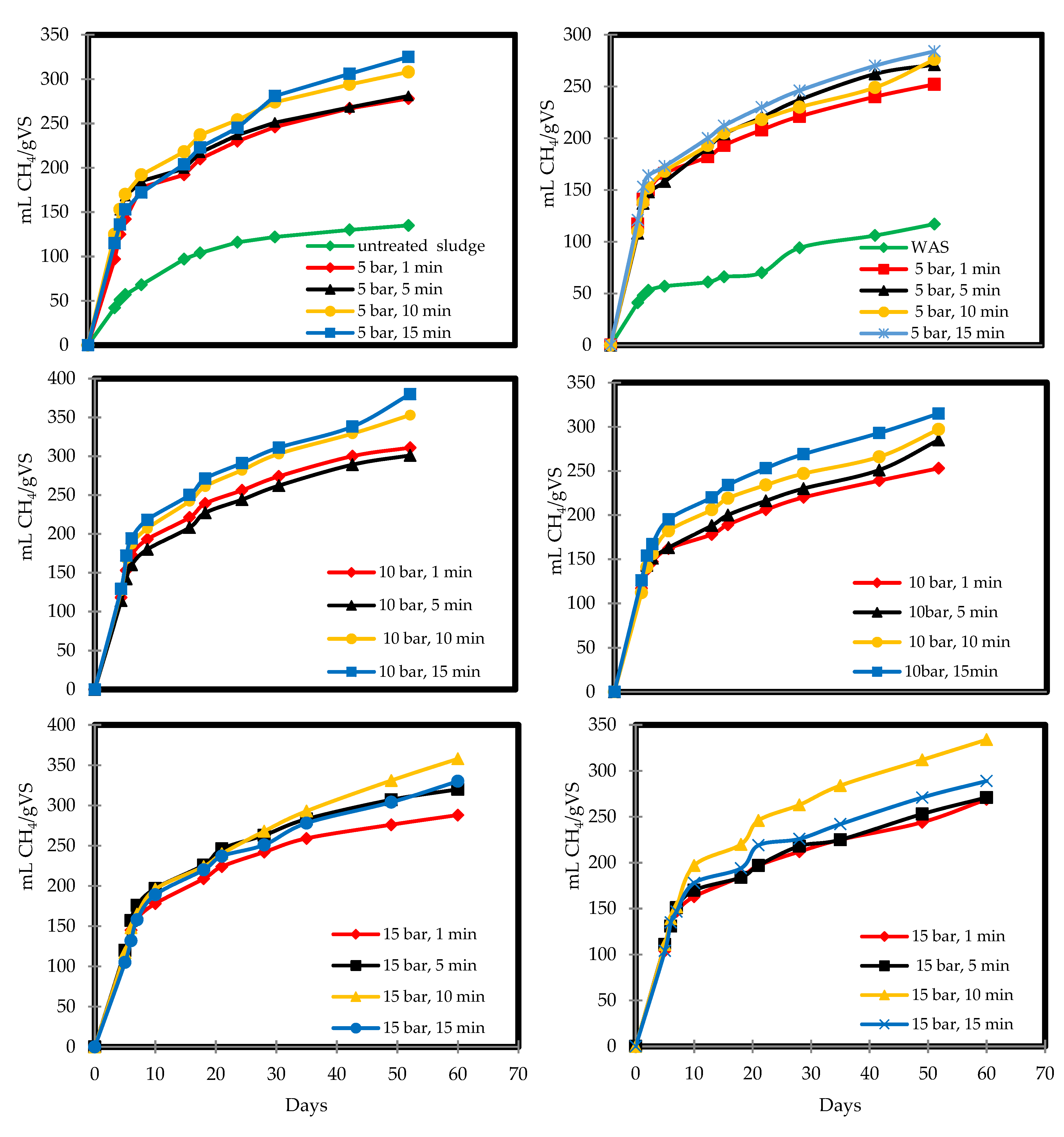
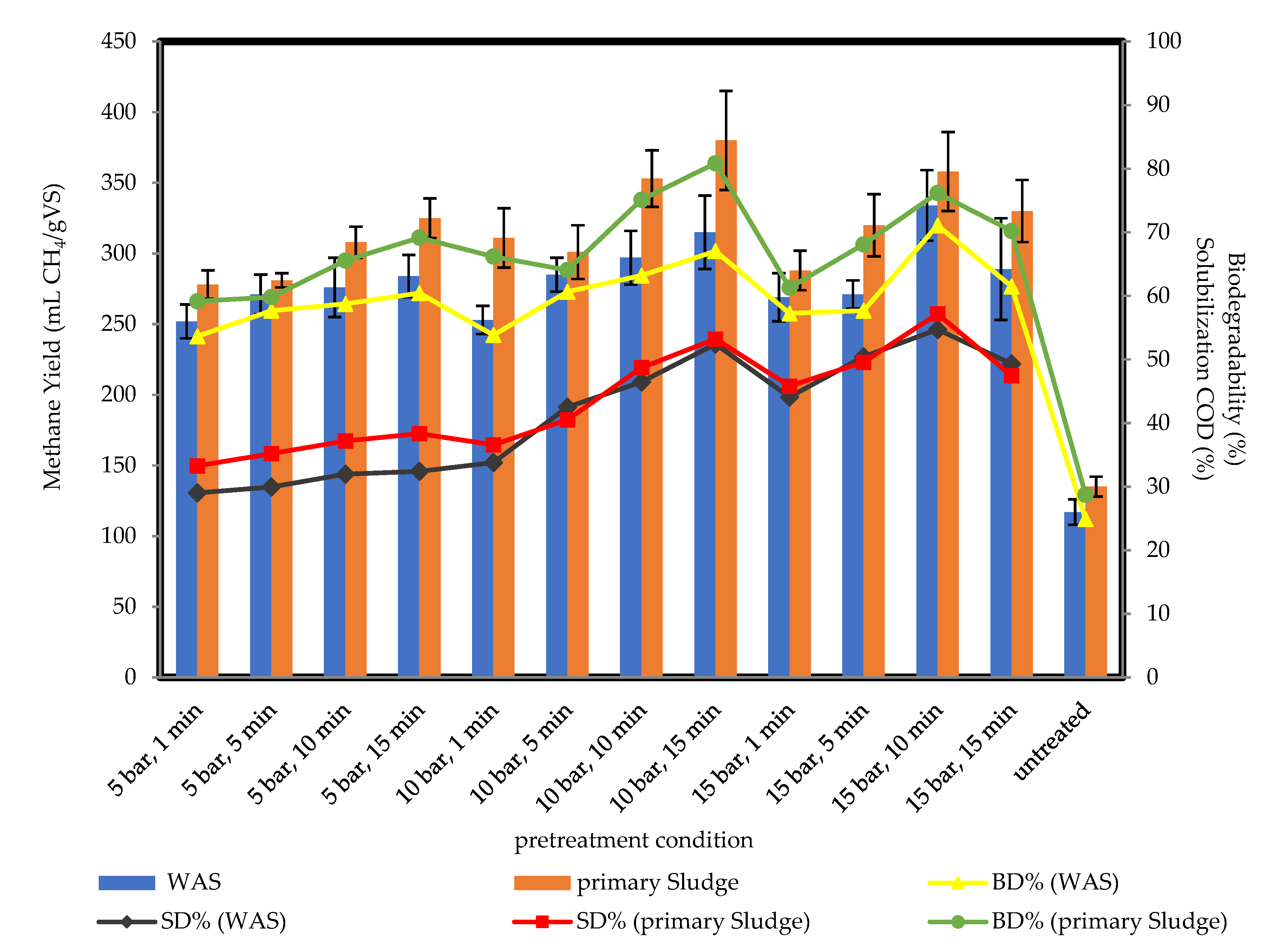
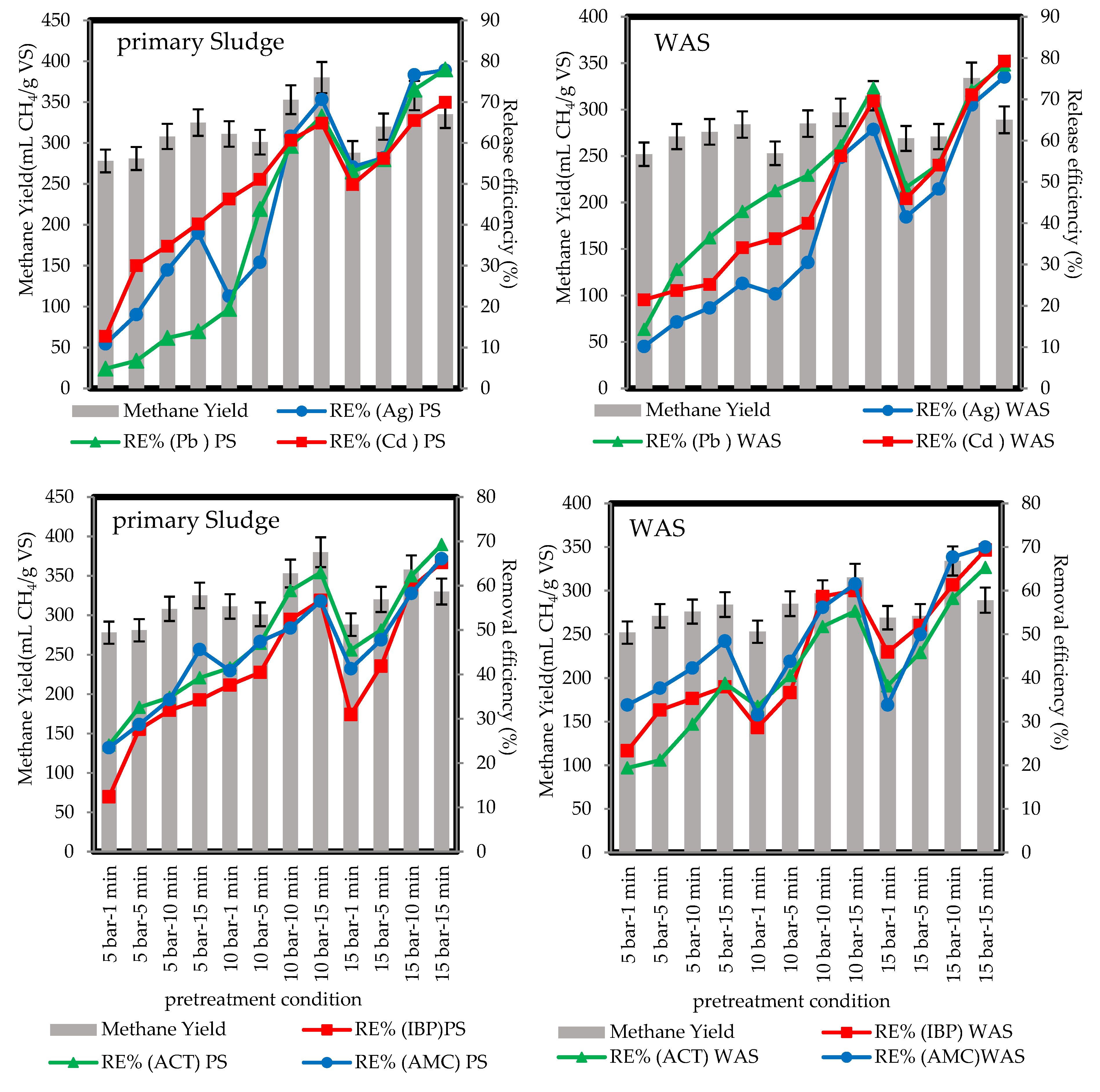
| Pretreatment Conditions | SD% | VS/TS | pH | |||||
|---|---|---|---|---|---|---|---|---|
| Pressure (bar) | Time (min) | T (°C) | Primary Sludge | WAS | Primary Sludge | WAS | Primary Sludge | WAS |
| 5 | 1 | 160 | 33 ± 2 | 29 ± 1 | 0.64 ± 0.2 | 0.55 ± 0.1 | 7.7 ± 0.1 | 7.6 ± 0.08 |
| 5 | 5 | 160 | 35 ± 2 | 30 ± 1 | 0.63 ± 0.2 | 0.54 ± 0.13 | 7.6 ± 0.1 | 7.5 ± 0.11 |
| 5 | 10 | 160 | 37 ± 1 | 32 ± 3 | 0.62 ± 0.1 | 0.53 ± 0.16 | 7.4 ± 0.08 | 7.3 ± 0.12 |
| 5 | 15 | 160 | 38 ± 3 | 32 ± 2 | 0.61 ± 0.15 | 0.51 ± 0.1 | 7.1 ± 0.06 | 7.3 ± 0.1 |
| 10 | 1 | 185 | 36 ± 2 | 33 ± 1 | 0.63 ± 0.28 | 0.51 ± 0.19 | 7.2 ± 0.1 | 7.1 ± 0.07 |
| 10 | 5 | 185 | 40 ± 3 | 42 ± 2 | 0.62 ± 0.2 | 0.49 ± 0.15 | 7 ± 0.05 | 6.8 ± 0.09 |
| 10 | 10 | 185 | 48 ± 5 | 46 ± 4 | 0.59 ± 0.24 | 0.48 ± 0.14 | 6.6 ± 0.07 | 6.6 ± 0.11 |
| 10 | 15 | 185 | 53 ± 4 | 52 ± 4 | 0.58 ± 0.3 | 0.50 ± 0.09 | 6.1 ± 0.03 | 6.5 ± 0.15 |
| 15 | 1 | 205 | 45 ± 3 | 44 ± 2 | 0.62 ± 0.1 | 0.48 ± 0.12 | 7.1 ± 0.11 | 6.7 ± 0.1 |
| 15 | 5 | 205 | 49 ± 2 | 50 ± 3 | 0.58 ± 0.17 | 0.47 ± 0.18 | 6.3 ± 0.05 | 6.5 ± 0.13 |
| 15 | 10 | 205 | 57 ± 4 | 54 ± 5 | 0.57 ± 0.22 | 0.46 ± 0.26 | 6 ± 0.09 | 6.1 ± 0.14 |
| 15 | 15 | 205 | 47 ± 3 | 49 ± 2 | 0.60 ± 0.14 | 0.47 ± 0.21 | 6.2 ± 0.14 | 6.2 ± 0.12 |
| Untreated | 0.64 ± 0.1 | 0.55 ± 0.14 | 7.8 ± 0.12 | 7.6 ± 0.09 | ||||
| Pretreatment Conditions | Methane Production | |||||
|---|---|---|---|---|---|---|
| Pressure (bar) | Time (min) | T (°C) | Waste Activated Sludge | Primary Sludge | ||
| Production Rate mL CH4/day | Yield mL CH4/g VS | Production Rate mL CH4/day | Yield mL CH4/g VS | |||
| 5 | 1 | 160 | 166 | 252 ± 12 | 178 | 278 ± 10 |
| 5 | 5 | 160 | 158 | 271 ± 14 | 185 | 281 ± 5 |
| 5 | 10 | 160 | 168 | 276 ± 21 | 192 | 308 ± 11 |
| 5 | 15 | 160 | 173 | 284 ± 15 | 172 | 325 ± 14 |
| 10 | 1 | 185 | 162 | 253 ± 10 | 193 | 311 ± 21 |
| 10 | 5 | 185 | 163 | 285 ± 12 | 180 | 301 ± 19 |
| 10 | 10 | 185 | 182 | 297 ± 19 | 207 | 353 ± 20 |
| 10 | 15 | 185 | 192 | 315 ± 26 | 218 | 380 ± 35 |
| 15 | 1 | 205 | 163 | 269 ± 17 | 178 | 288 ± 14 |
| 15 | 5 | 205 | 170 | 271 ± 10 | 197 | 320 ± 22 |
| 15 | 10 | 205 | 197 | 334 ± 25 | 196 | 358 ± 28 |
| 15 | 15 | 205 | 178 | 289 ± 36 | 189 | 335 ± 22 |
| Untreated | 57 | 117 ± 7 | 68 | 135 ± 9 | ||
| Analysis of Variance | ||||||||
|---|---|---|---|---|---|---|---|---|
| Source | DF | Seq SS | Adj SS | Adj MS | F-Value | p-Value | Coef | SE Coef |
| pressure | 1 | 1384.6 | 1132.7 | 1132.7 | 5.60 | 0.039 | 2.1024 | 0.8883 |
| time | 3 | 3836.7 | 3836.7 | 1278.9 | 6.32 | 0.011 | 2.9496 | 0.9589 |
| Error | 10 | 2022.1 | 2022.1 | 202.2 | ||||
| Total | 14 | 7243.3 | ||||||
| S = 14.2199 R-Sq = 72.08% R-Sq(adj) = 60.92% | ||||||||
© 2020 by the authors. Licensee MDPI, Basel, Switzerland. This article is an open access article distributed under the terms and conditions of the Creative Commons Attribution (CC BY) license (http://creativecommons.org/licenses/by/4.0/).
Share and Cite
Lotfi Aski, A.; Borghei, A.; Zenouzi, A.; Ashrafi, N.; Taherzadeh, M.J. Steam Explosion Pretreatment of Sludge for Pharmaceutical Removal and Heavy Metal Release to Improve Biodegradability and Biogas Production. Fermentation 2020, 6, 34. https://doi.org/10.3390/fermentation6010034
Lotfi Aski A, Borghei A, Zenouzi A, Ashrafi N, Taherzadeh MJ. Steam Explosion Pretreatment of Sludge for Pharmaceutical Removal and Heavy Metal Release to Improve Biodegradability and Biogas Production. Fermentation. 2020; 6(1):34. https://doi.org/10.3390/fermentation6010034
Chicago/Turabian StyleLotfi Aski, Abolfazl, Alimohammad Borghei, Ali Zenouzi, Nariman Ashrafi, and Mohammad J. Taherzadeh. 2020. "Steam Explosion Pretreatment of Sludge for Pharmaceutical Removal and Heavy Metal Release to Improve Biodegradability and Biogas Production" Fermentation 6, no. 1: 34. https://doi.org/10.3390/fermentation6010034
APA StyleLotfi Aski, A., Borghei, A., Zenouzi, A., Ashrafi, N., & Taherzadeh, M. J. (2020). Steam Explosion Pretreatment of Sludge for Pharmaceutical Removal and Heavy Metal Release to Improve Biodegradability and Biogas Production. Fermentation, 6(1), 34. https://doi.org/10.3390/fermentation6010034






